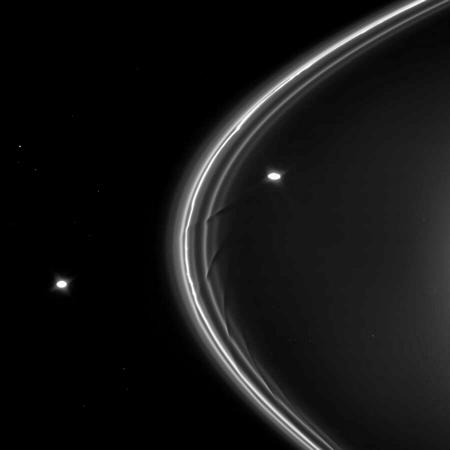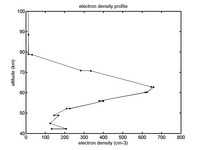|
Hates the Infotainment
Join Date: May 2004
Location: NSA Archives
|
I didn't think vortices had sides.
 |
| quote |
|
Veteran Member
Join Date: May 2004
|
Read the article. That's the neat part.
 Stable vortices that aren't round, but polygonal. |
| quote |
|
BANNED
I am worthless beyond hope. Join Date: May 2004
Location: Inner Swabia. If you have to ask twice, don't.
|
Quote:
|
|
| quote |
|
Space Pirate
Join Date: May 2004
Location: Atlanta
|
HOLY MOLY!!!!
That hexagon is bigger than three Earths!!!    |
| quote |
|
Veteran Member
Join Date: May 2004
|
Yeah, I love that the running theory is that it is tidal-locked with the core at a 10+hr period, when according to the polygonal vortex experiment, that core should be frickin' flying.
|
| quote |
|
Antimatter Man
Join Date: May 2004
Location: that interweb thing
|
But this story on Enceladus outgassing getting ionized and apparently borking the rotation of the magnetic field implies that we still don't know the actual rotation period of Saturn itself.
Quote:
All those who believe in telekinesis, raise my hand. |
|
| quote |
|
Hates the Infotainment
Join Date: May 2004
Location: NSA Archives
|
That is bad-ass, I must say...
Also I caught part of a show on M-theory last night where they've apparently decided it's possible that the big-bang was nothing more than the "membranes" of two parallel universes touching at a specific point, as a result of "ripples" or waves. And that therefore time does not have to halt at the big bang but can keep on tracking backwards, and that also there are possibly countless such universal planes, floating around out there... ...because you know this cosmological stuff isn't mind-boggling enough already! We need to be more baffled!  ...into the light of a dark black night. |
| quote |
|
Hates the Infotainment
Join Date: May 2004
Location: NSA Archives
|
Thought I would borrow your thread for a bit... seems we'd better get cracking on the NGT and near-light-speed propulsion. There may now be a destination about 20 light years away, in case we need to start a human colony outside earth. Maybe in 60 or 70 years the technology will exist to contemplate going there. Assuming there are no locals and assuming if there are, that we're welcome. I know I wouldn't invite us over for dinner.
 ...into the light of a dark black night. |
| quote |
|
Antimatter Man
Join Date: May 2004
Location: that interweb thing
|
Two new stunners from the spacecraft. Next Titan Flyby under 9 days.
Quote:
|
|
| quote |
|
Hates the Infotainment
Join Date: May 2004
Location: NSA Archives
|
Man... that is one mind-bogglingly large planet. Hard to believe there's nothing under there but gas and a metallic core.
|
| quote |
|
Antimatter Man
Join Date: May 2004
Location: that interweb thing
|
Huygens discovers evidence of hidden ocean on Titan
Quote:
Last edited by curiousuburb : 2007-06-05 at 11:56. Reason: correction |
|
| quote |
|
Thunderbolt, fuck yeah!
Join Date: Jan 2005
Location: Denmark
|
Cool. Now how do we get a submarine up there?
 |
| quote |
|
Antimatter Man
Join Date: May 2004
Location: that interweb thing
|
|
| quote |
|
Thunderbolt, fuck yeah!
Join Date: Jan 2005
Location: Denmark
|
Quote:
 |
|
| quote |
|
Hates the Infotainment
Join Date: May 2004
Location: NSA Archives
|
This stuff is a trip... how amazing that we're doing this kind of science. Gives me hope for mankind, if we can keep from asploding each other, dying from plagues, etc.
...into the light of a dark black night. |
| quote |
|
Antimatter Man
Join Date: May 2004
Location: that interweb thing
|
Iapetus Bulge explained
 Quote:
Quote:
Quote:
  All those who believe in telekinesis, raise my hand. |
|||
| quote |
|
Antimatter Man
Join Date: May 2004
Location: that interweb thing
|
Cassini's only close (1600 km) flyby of the curious moon Iapetus (discovered by the original Giovanni Cassini in 1671) is done.
Despite a cosmic ray hit that put the spacecraft into safe mode and delayed downlink of the data, there are some impressive new images of the 'yin-yang moon' with the walnut ridge. Quote:
Quote:
 And Arthur C Clarke webcast a message (click pic above for link) for the JPL/Cassini folks to mark the flyby of the moon he actually chose for the big Monolith in 2001. The clip explains why Kubrick switched to Jupiter in the film when the book used Saturn. Space science and film trivia connected by a brilliantly prescient author... trifecta!  All those who believe in telekinesis, raise my hand. |
|
| quote |
|
Hates the Infotainment
Join Date: May 2004
Location: NSA Archives
|
Sorta related
http://news.bbc.co.uk/2/hi/science/nature/7082257.stm Seems the Cancri system is uber-planetized. |
| quote |
|
Hates the Infotainment
Join Date: May 2004
Location: NSA Archives
|
More Astro-news.... we're always talking about planets getting pummeled by asteroids and such. How about every planetary system on the edge of an entire galaxy getting wiped out by a SMBH "jet"?
http://news.bbc.co.uk/2/hi/science/nature/7148671.stm  ...into the light of a dark black night. |
| quote |
|
Antimatter Man
Join Date: May 2004
Location: that interweb thing
|
Meanwhile, the boffins are bickering over the composition of the Enceladus jets.
Grains of salt should be taken when reading this story... but might not be detected.  http://news.bbc.co.uk/1/hi/sci/tech/7145530.stm Quote:
All those who believe in telekinesis, raise my hand. |
|
| quote |
|
Antimatter Man
Join Date: May 2004
Location: that interweb thing
|
 Cassini at Saturn Interactive Explorer (CASSIE) Real data... handy web 3D browser plugin.    Quote:
All those who believe in telekinesis, raise my hand. |
|
| quote |
|
Antimatter Man
Join Date: May 2004
Location: that interweb thing
|
Enceladus close pass in 1 hour.
 50km above the surface and through the geysers at under 200km altitude to sample the contents. Sadly, the imaging array will be turned out to space during the geyser dive so that the particle analyzers can get their best sniff.
Quote:
 (With new close up images of the Northern hemisphere due after this flyby). Oh... and apparently, Rhea has Rings. First moon in the solar system to have them. All those who believe in telekinesis, raise my hand. |
|
| quote |
|
Antimatter Man
Join Date: May 2004
Location: that interweb thing
|
Cassini picks up a mushroom... Extended mission!¡!
And the CASSIE 3D explorer is updated to v2.0  Quote:
All those who believe in telekinesis, raise my hand. |
|
| quote |
|
Antimatter Man
Join Date: May 2004
Location: that interweb thing
|
Cassini has captured Prometheus colliding with the F ring, which creates a "streamer;" material being pulled from the ring by the moon's gravity, leaving behind a dark channel.
Quote:
Quote:
 So the shepherds do their thing here... and apparently planets do it around other stars... Hubble just announced photos of an ExoPlanet around Fomalhaut (25ly away)...  Wo0t!   All those who believe in telekinesis, raise my hand. |
||
| quote |
|
Hates the Infotainment
Join Date: May 2004
Location: NSA Archives
|
Looks like a mandlebot image. Very cool!
|
| quote |
|
Antimatter Man
Join Date: May 2004
Location: that interweb thing
|
So in addition to updating the main Cassini mission site in honour of the extended 'Equinox' mission...
Two new true-colour photo releases that are candidates for awesome desktop pictures (I've tried to use thumbs to limit scroll, but extra res is available). Detailed labels of the rings and gaps Quote:
Quote:
 All those who believe in telekinesis, raise my hand. |
||
| quote |
|
Veteran Member
Join Date: May 2004
|
|
| quote |
|
Veteran Member
Join Date: Jun 2005
Location: State of Flux
|
Great posts, cs! Stunning stuff.
|
| quote |
|
Antimatter Man
Join Date: May 2004
Location: that interweb thing
|
On Aug 11th the Rings will 'vanish'.
Quote:
Cassini spots new moonlet  Quote:
All those who believe in telekinesis, raise my hand. |
||
| quote |
|
Rocket Surgeon
Join Date: Feb 2005
Location: The Canadark
|
Wait, that's no moon.
 Edit: Dammit! Low-res version of the same on page one of this thread! And I searched and everything. Move on, nothing to see here. Except a giant planet-destroying space station, obviously. Last edited by Bryson : 2010-02-23 at 19:56. Reason: Beaten to it. |
| quote |
| Posting Rules | Navigation |
|
Page 7 of 8 First Previous 3 4 5 6 [7] 8 Next |
| Thread Tools | |
«
Previous Thread
|
Next Thread
»
All times are GMT -5. The time now is 18:52.

 <--- Not to scale, obviously
<--- Not to scale, obviously










 The 'Voyager' Mountains
The 'Voyager' Mountains Coated Craters
Coated Craters Inky Stains on a Frozen Moon
Inky Stains on a Frozen Moon The Himalayas of Iapetus
The Himalayas of Iapetus Eyes on Iapetus!
Eyes on Iapetus! Exposing Iapetus' Dark Side
Exposing Iapetus' Dark Side
 ENCELADUS ORBITER CONCEPT
ENCELADUS ORBITER CONCEPT
 Click for video
Click for video


 Enceladus geysers
Enceladus geysers Titan, Land of Lakes.
Titan, Land of Lakes. Spongy Hyperion.
Spongy Hyperion. Titan's landscape, from Huygens
Titan's landscape, from Huygens Long-lived storm at Saturn's south pole.
Long-lived storm at Saturn's south pole.






